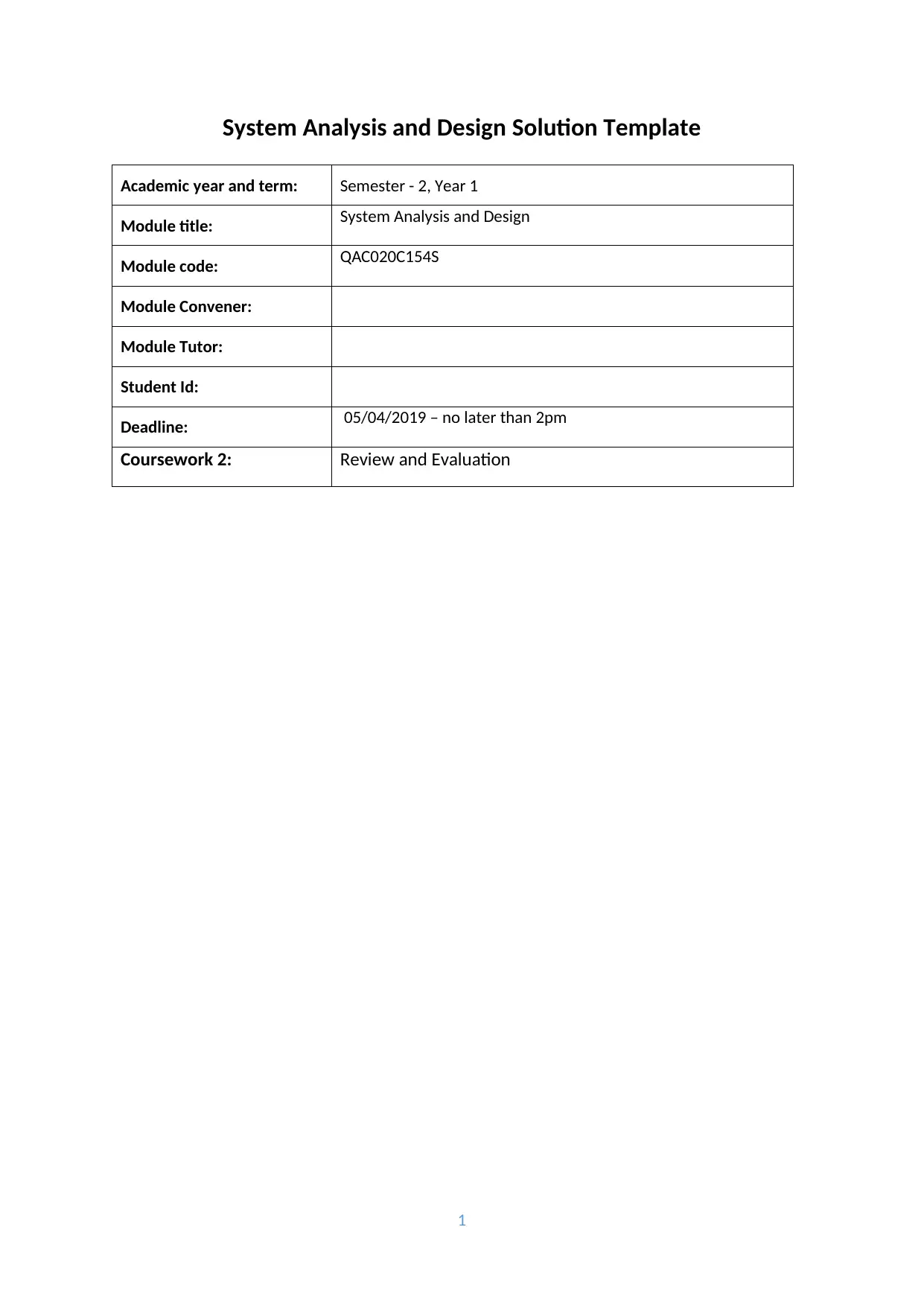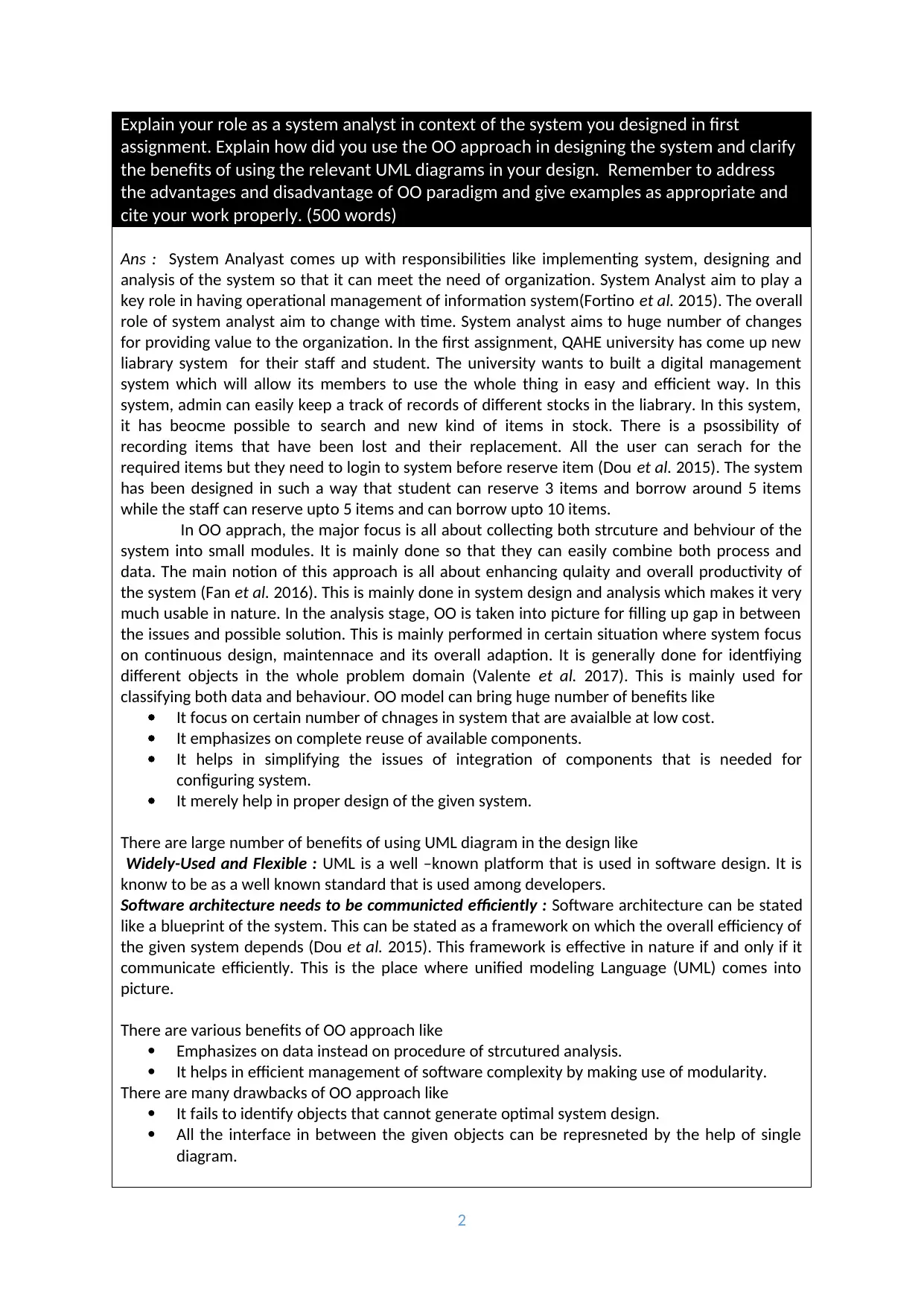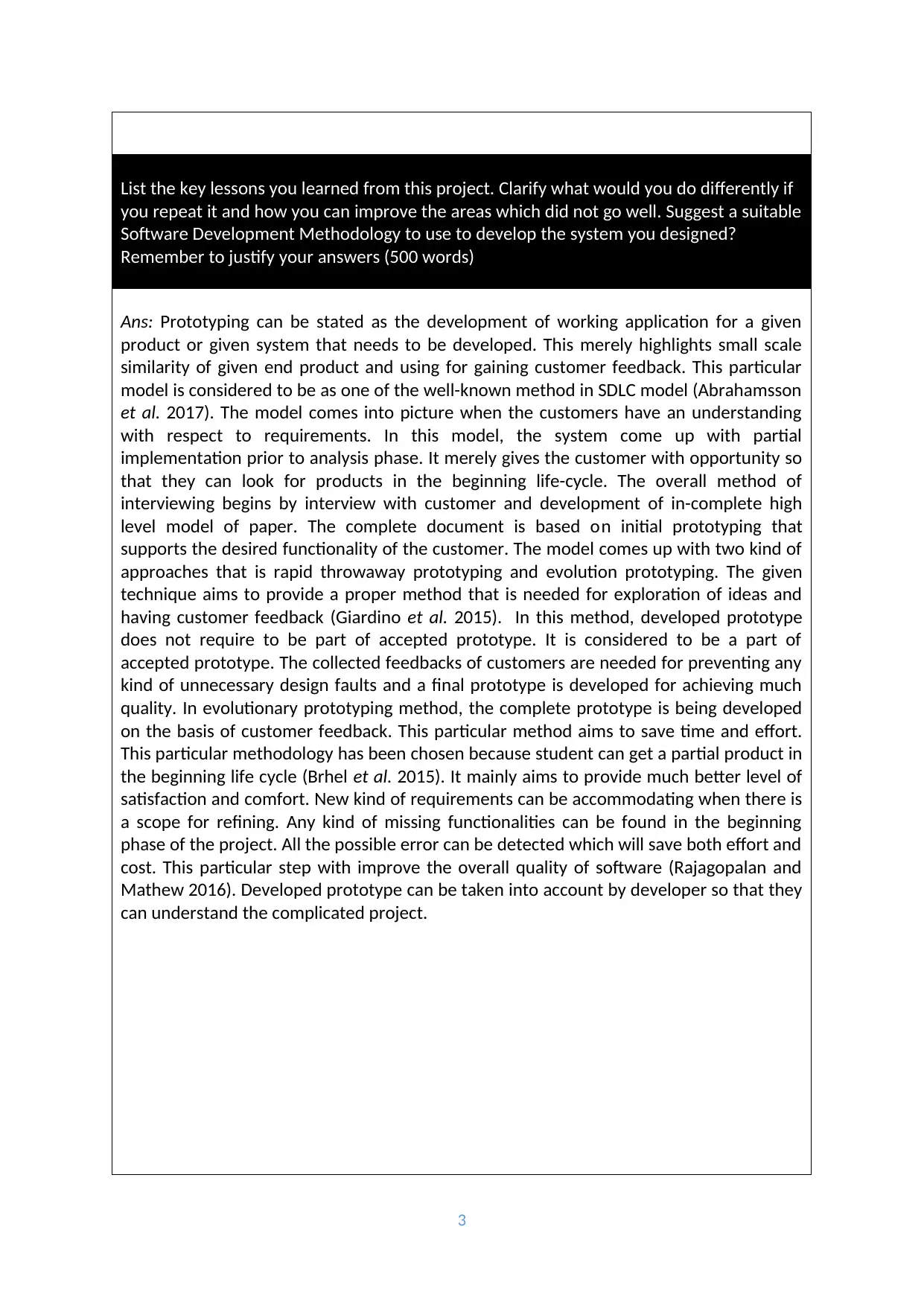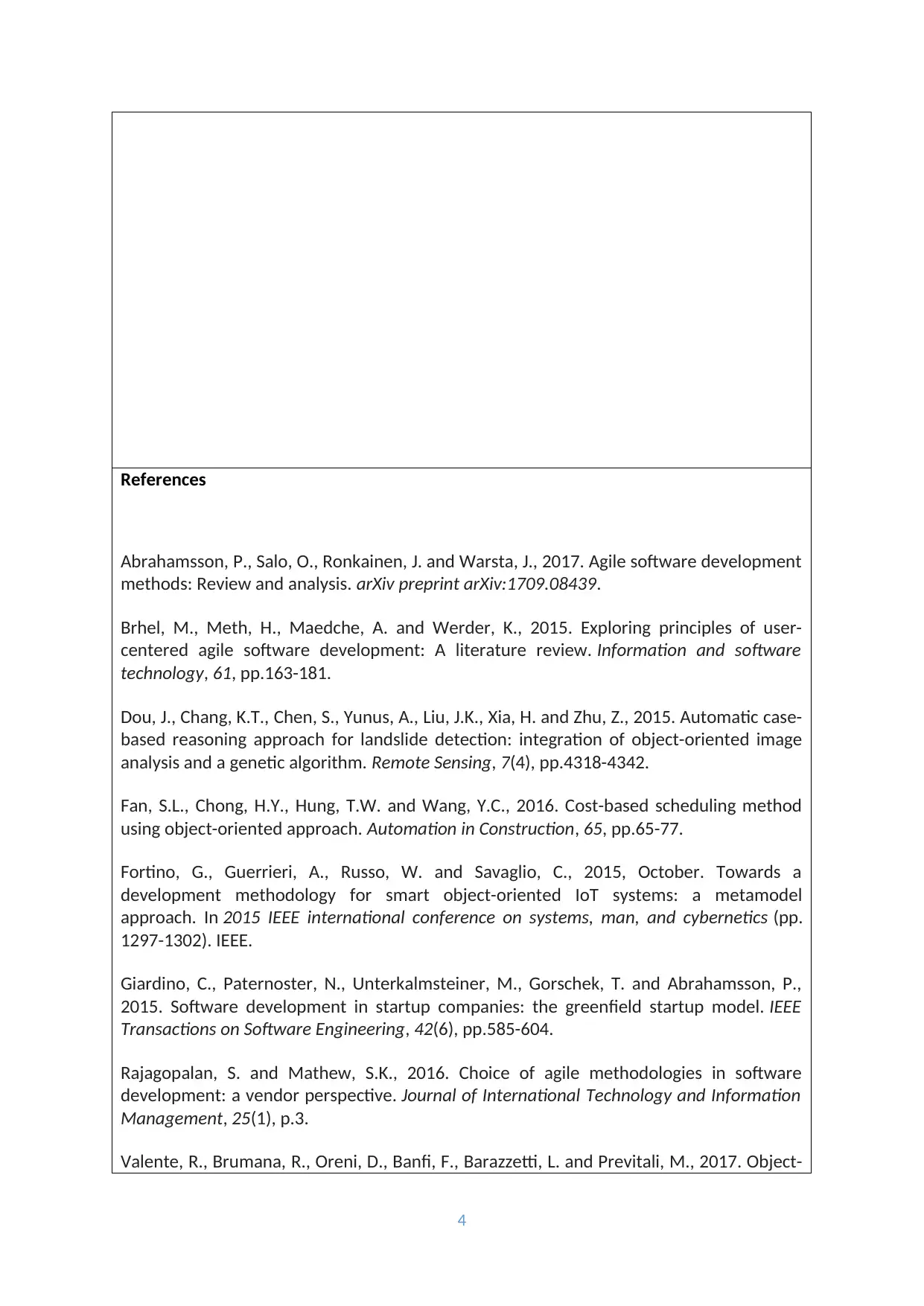System Analysis and Design Review: Lessons Learned and Methodology
VerifiedAdded on 2022/11/28
|5
|1556
|187
Report
AI Summary
This report provides a comprehensive review of system analysis and design, focusing on the student's role as a system analyst within the context of a library management system. The report details the application of the Object-Oriented (OO) approach in designing the system, emphasizing the use and benefits of Unified Modeling Language (UML) diagrams. It addresses the advantages and disadvantages of the OO paradigm, providing relevant examples. The student reflects on key lessons learned from the project, identifying areas for improvement and suggesting a suitable software development methodology, specifically prototyping, with justifications for its selection. The report references various academic sources to support its analysis and conclusions, providing a thorough evaluation of the system design process.

System Analysis and Design Solution Template
Academic year and term: Semester - 2, Year 1
Module title: System Analysis and Design
Module code: QAC020C154S
Module Convener:
Module Tutor:
Student Id:
Deadline: 05/04/2019 – no later than 2pm
Coursework 2: Review and Evaluation
1
Academic year and term: Semester - 2, Year 1
Module title: System Analysis and Design
Module code: QAC020C154S
Module Convener:
Module Tutor:
Student Id:
Deadline: 05/04/2019 – no later than 2pm
Coursework 2: Review and Evaluation
1
Paraphrase This Document
Need a fresh take? Get an instant paraphrase of this document with our AI Paraphraser

Explain your role as a system analyst in context of the system you designed in first
assignment. Explain how did you use the OO approach in designing the system and clarify
the benefits of using the relevant UML diagrams in your design. Remember to address
the advantages and disadvantage of OO paradigm and give examples as appropriate and
cite your work properly. (500 words)
Ans : System Analyast comes up with responsibilities like implementing system, designing and
analysis of the system so that it can meet the need of organization. System Analyst aim to play a
key role in having operational management of information system(Fortino et al. 2015). The overall
role of system analyst aim to change with time. System analyst aims to huge number of changes
for providing value to the organization. In the first assignment, QAHE university has come up new
liabrary system for their staff and student. The university wants to built a digital management
system which will allow its members to use the whole thing in easy and efficient way. In this
system, admin can easily keep a track of records of different stocks in the liabrary. In this system,
it has beocme possible to search and new kind of items in stock. There is a psossibility of
recording items that have been lost and their replacement. All the user can serach for the
required items but they need to login to system before reserve item (Dou et al. 2015). The system
has been designed in such a way that student can reserve 3 items and borrow around 5 items
while the staff can reserve upto 5 items and can borrow upto 10 items.
In OO apprach, the major focus is all about collecting both strcuture and behviour of the
system into small modules. It is mainly done so that they can easily combine both process and
data. The main notion of this approach is all about enhancing qulaity and overall productivity of
the system (Fan et al. 2016). This is mainly done in system design and analysis which makes it very
much usable in nature. In the analysis stage, OO is taken into picture for filling up gap in between
the issues and possible solution. This is mainly performed in certain situation where system focus
on continuous design, maintennace and its overall adaption. It is generally done for identfiying
different objects in the whole problem domain (Valente et al. 2017). This is mainly used for
classifying both data and behaviour. OO model can bring huge number of benefits like
It focus on certain number of chnages in system that are avaialble at low cost.
It emphasizes on complete reuse of available components.
It helps in simplifying the issues of integration of components that is needed for
configuring system.
It merely help in proper design of the given system.
There are large number of benefits of using UML diagram in the design like
Widely-Used and Flexible : UML is a well –known platform that is used in software design. It is
knonw to be as a well known standard that is used among developers.
Software architecture needs to be communicted efficiently : Software architecture can be stated
like a blueprint of the system. This can be stated as a framework on which the overall efficiency of
the given system depends (Dou et al. 2015). This framework is effective in nature if and only if it
communicate efficiently. This is the place where unified modeling Language (UML) comes into
picture.
There are various benefits of OO approach like
Emphasizes on data instead on procedure of strcutured analysis.
It helps in efficient management of software complexity by making use of modularity.
There are many drawbacks of OO approach like
It fails to identify objects that cannot generate optimal system design.
All the interface in between the given objects can be represneted by the help of single
diagram.
2
assignment. Explain how did you use the OO approach in designing the system and clarify
the benefits of using the relevant UML diagrams in your design. Remember to address
the advantages and disadvantage of OO paradigm and give examples as appropriate and
cite your work properly. (500 words)
Ans : System Analyast comes up with responsibilities like implementing system, designing and
analysis of the system so that it can meet the need of organization. System Analyst aim to play a
key role in having operational management of information system(Fortino et al. 2015). The overall
role of system analyst aim to change with time. System analyst aims to huge number of changes
for providing value to the organization. In the first assignment, QAHE university has come up new
liabrary system for their staff and student. The university wants to built a digital management
system which will allow its members to use the whole thing in easy and efficient way. In this
system, admin can easily keep a track of records of different stocks in the liabrary. In this system,
it has beocme possible to search and new kind of items in stock. There is a psossibility of
recording items that have been lost and their replacement. All the user can serach for the
required items but they need to login to system before reserve item (Dou et al. 2015). The system
has been designed in such a way that student can reserve 3 items and borrow around 5 items
while the staff can reserve upto 5 items and can borrow upto 10 items.
In OO apprach, the major focus is all about collecting both strcuture and behviour of the
system into small modules. It is mainly done so that they can easily combine both process and
data. The main notion of this approach is all about enhancing qulaity and overall productivity of
the system (Fan et al. 2016). This is mainly done in system design and analysis which makes it very
much usable in nature. In the analysis stage, OO is taken into picture for filling up gap in between
the issues and possible solution. This is mainly performed in certain situation where system focus
on continuous design, maintennace and its overall adaption. It is generally done for identfiying
different objects in the whole problem domain (Valente et al. 2017). This is mainly used for
classifying both data and behaviour. OO model can bring huge number of benefits like
It focus on certain number of chnages in system that are avaialble at low cost.
It emphasizes on complete reuse of available components.
It helps in simplifying the issues of integration of components that is needed for
configuring system.
It merely help in proper design of the given system.
There are large number of benefits of using UML diagram in the design like
Widely-Used and Flexible : UML is a well –known platform that is used in software design. It is
knonw to be as a well known standard that is used among developers.
Software architecture needs to be communicted efficiently : Software architecture can be stated
like a blueprint of the system. This can be stated as a framework on which the overall efficiency of
the given system depends (Dou et al. 2015). This framework is effective in nature if and only if it
communicate efficiently. This is the place where unified modeling Language (UML) comes into
picture.
There are various benefits of OO approach like
Emphasizes on data instead on procedure of strcutured analysis.
It helps in efficient management of software complexity by making use of modularity.
There are many drawbacks of OO approach like
It fails to identify objects that cannot generate optimal system design.
All the interface in between the given objects can be represneted by the help of single
diagram.
2

List the key lessons you learned from this project. Clarify what would you do differently if
you repeat it and how you can improve the areas which did not go well. Suggest a suitable
Software Development Methodology to use to develop the system you designed?
Remember to justify your answers (500 words)
Ans: Prototyping can be stated as the development of working application for a given
product or given system that needs to be developed. This merely highlights small scale
similarity of given end product and using for gaining customer feedback. This particular
model is considered to be as one of the well-known method in SDLC model (Abrahamsson
et al. 2017). The model comes into picture when the customers have an understanding
with respect to requirements. In this model, the system come up with partial
implementation prior to analysis phase. It merely gives the customer with opportunity so
that they can look for products in the beginning life-cycle. The overall method of
interviewing begins by interview with customer and development of in-complete high
level model of paper. The complete document is based on initial prototyping that
supports the desired functionality of the customer. The model comes up with two kind of
approaches that is rapid throwaway prototyping and evolution prototyping. The given
technique aims to provide a proper method that is needed for exploration of ideas and
having customer feedback (Giardino et al. 2015). In this method, developed prototype
does not require to be part of accepted prototype. It is considered to be a part of
accepted prototype. The collected feedbacks of customers are needed for preventing any
kind of unnecessary design faults and a final prototype is developed for achieving much
quality. In evolutionary prototyping method, the complete prototype is being developed
on the basis of customer feedback. This particular method aims to save time and effort.
This particular methodology has been chosen because student can get a partial product in
the beginning life cycle (Brhel et al. 2015). It mainly aims to provide much better level of
satisfaction and comfort. New kind of requirements can be accommodating when there is
a scope for refining. Any kind of missing functionalities can be found in the beginning
phase of the project. All the possible error can be detected which will save both effort and
cost. This particular step with improve the overall quality of software (Rajagopalan and
Mathew 2016). Developed prototype can be taken into account by developer so that they
can understand the complicated project.
3
you repeat it and how you can improve the areas which did not go well. Suggest a suitable
Software Development Methodology to use to develop the system you designed?
Remember to justify your answers (500 words)
Ans: Prototyping can be stated as the development of working application for a given
product or given system that needs to be developed. This merely highlights small scale
similarity of given end product and using for gaining customer feedback. This particular
model is considered to be as one of the well-known method in SDLC model (Abrahamsson
et al. 2017). The model comes into picture when the customers have an understanding
with respect to requirements. In this model, the system come up with partial
implementation prior to analysis phase. It merely gives the customer with opportunity so
that they can look for products in the beginning life-cycle. The overall method of
interviewing begins by interview with customer and development of in-complete high
level model of paper. The complete document is based on initial prototyping that
supports the desired functionality of the customer. The model comes up with two kind of
approaches that is rapid throwaway prototyping and evolution prototyping. The given
technique aims to provide a proper method that is needed for exploration of ideas and
having customer feedback (Giardino et al. 2015). In this method, developed prototype
does not require to be part of accepted prototype. It is considered to be a part of
accepted prototype. The collected feedbacks of customers are needed for preventing any
kind of unnecessary design faults and a final prototype is developed for achieving much
quality. In evolutionary prototyping method, the complete prototype is being developed
on the basis of customer feedback. This particular method aims to save time and effort.
This particular methodology has been chosen because student can get a partial product in
the beginning life cycle (Brhel et al. 2015). It mainly aims to provide much better level of
satisfaction and comfort. New kind of requirements can be accommodating when there is
a scope for refining. Any kind of missing functionalities can be found in the beginning
phase of the project. All the possible error can be detected which will save both effort and
cost. This particular step with improve the overall quality of software (Rajagopalan and
Mathew 2016). Developed prototype can be taken into account by developer so that they
can understand the complicated project.
3
⊘ This is a preview!⊘
Do you want full access?
Subscribe today to unlock all pages.

Trusted by 1+ million students worldwide

References
Abrahamsson, P., Salo, O., Ronkainen, J. and Warsta, J., 2017. Agile software development
methods: Review and analysis. arXiv preprint arXiv:1709.08439.
Brhel, M., Meth, H., Maedche, A. and Werder, K., 2015. Exploring principles of user-
centered agile software development: A literature review. Information and software
technology, 61, pp.163-181.
Dou, J., Chang, K.T., Chen, S., Yunus, A., Liu, J.K., Xia, H. and Zhu, Z., 2015. Automatic case-
based reasoning approach for landslide detection: integration of object-oriented image
analysis and a genetic algorithm. Remote Sensing, 7(4), pp.4318-4342.
Fan, S.L., Chong, H.Y., Hung, T.W. and Wang, Y.C., 2016. Cost-based scheduling method
using object-oriented approach. Automation in Construction, 65, pp.65-77.
Fortino, G., Guerrieri, A., Russo, W. and Savaglio, C., 2015, October. Towards a
development methodology for smart object-oriented IoT systems: a metamodel
approach. In 2015 IEEE international conference on systems, man, and cybernetics (pp.
1297-1302). IEEE.
Giardino, C., Paternoster, N., Unterkalmsteiner, M., Gorschek, T. and Abrahamsson, P.,
2015. Software development in startup companies: the greenfield startup model. IEEE
Transactions on Software Engineering, 42(6), pp.585-604.
Rajagopalan, S. and Mathew, S.K., 2016. Choice of agile methodologies in software
development: a vendor perspective. Journal of International Technology and Information
Management, 25(1), p.3.
Valente, R., Brumana, R., Oreni, D., Banfi, F., Barazzetti, L. and Previtali, M., 2017. Object-
4
Abrahamsson, P., Salo, O., Ronkainen, J. and Warsta, J., 2017. Agile software development
methods: Review and analysis. arXiv preprint arXiv:1709.08439.
Brhel, M., Meth, H., Maedche, A. and Werder, K., 2015. Exploring principles of user-
centered agile software development: A literature review. Information and software
technology, 61, pp.163-181.
Dou, J., Chang, K.T., Chen, S., Yunus, A., Liu, J.K., Xia, H. and Zhu, Z., 2015. Automatic case-
based reasoning approach for landslide detection: integration of object-oriented image
analysis and a genetic algorithm. Remote Sensing, 7(4), pp.4318-4342.
Fan, S.L., Chong, H.Y., Hung, T.W. and Wang, Y.C., 2016. Cost-based scheduling method
using object-oriented approach. Automation in Construction, 65, pp.65-77.
Fortino, G., Guerrieri, A., Russo, W. and Savaglio, C., 2015, October. Towards a
development methodology for smart object-oriented IoT systems: a metamodel
approach. In 2015 IEEE international conference on systems, man, and cybernetics (pp.
1297-1302). IEEE.
Giardino, C., Paternoster, N., Unterkalmsteiner, M., Gorschek, T. and Abrahamsson, P.,
2015. Software development in startup companies: the greenfield startup model. IEEE
Transactions on Software Engineering, 42(6), pp.585-604.
Rajagopalan, S. and Mathew, S.K., 2016. Choice of agile methodologies in software
development: a vendor perspective. Journal of International Technology and Information
Management, 25(1), p.3.
Valente, R., Brumana, R., Oreni, D., Banfi, F., Barazzetti, L. and Previtali, M., 2017. Object-
4
Paraphrase This Document
Need a fresh take? Get an instant paraphrase of this document with our AI Paraphraser

oriented approach for 3D archaeological documentation.
5
5
1 out of 5
Related Documents
Your All-in-One AI-Powered Toolkit for Academic Success.
+13062052269
info@desklib.com
Available 24*7 on WhatsApp / Email
![[object Object]](/_next/static/media/star-bottom.7253800d.svg)
Unlock your academic potential
Copyright © 2020–2025 A2Z Services. All Rights Reserved. Developed and managed by ZUCOL.




